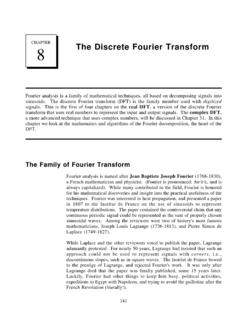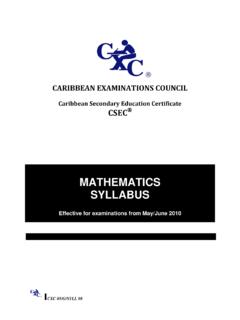Transcription of Beads Under the Cloud - GRREC Leadership Networks
1 Beads Under the Cloud Intermediate/Middle School Grades Problem Solving Mathematics Formative Assessment Lesson Designed and revised by Kentucky Department of Education Mathematics Specialists Field-tested by Kentucky Mathematics Leadership Network Teachers If you encounter errors or other issues, please contact the KDE team at: Created for the sole purpose of assisting teachers as they develop student understanding of Kentucky's Core Academic Standard through the use of highly effective teaching and learning. Not intended for sale. Formative Assessment Lesson Materials Revised Alpha Version April 2012.
2 Beads Under the Cloud Intermediate/Middle School Grades This problem solving Formative Assessment Lesson is designed to be part of an instructional unit. The results of this task should be used to inform the instruction that will take place for the remainder of the unit. Mathematical goals This problem solving lesson is intended to help you assess how well students are able to identify patterns (both linear and exponential) in a realistic context: the number of Beads of different colors that are hidden behind the Cloud . In particular, this problem solving lesson aims to identify and help students who have difficulties with: Choosing an appropriate, systematic way to collect and organize data.
3 Examining the data and looking for patterns Describing and explaining findings clearly and effectively. Common Core State Standards . This lesson involves a range of mathematical practices from the standards, with emphasis on: 1. Make sense of problems and persevere in solving them. 3. Construct viable arguments and critique the reasoning of others. 7. Look for and make use of structure. 8. Look for and make use of repeated reasoning. This lesson asks students to select and apply mathematical content from across the grades, including the content standards: 4-OA: Generate and analyze patterns.
4 5-OA: Analyze patterns and relationships 6-EE: Represent and analyze quantitative relationships between dependent and independent variables. 8-F: Use functions to model relationships between quantities. F-LE: Linear, Quadratic, and Exponential Models Introduction This lesson is structured in the following way: Before the lesson, students attempt the task individually. You then review their work and formulate questions for students to answer in order for them to improve their work. At the start of the lesson, students work individually to answer your questions. Next, they work collaboratively, in small groups, to produce a better collective solution than those they produced individually.
5 Throughout their work, they justify and explain their decisions to peers. In the same small groups, students critique examples of other students' work. In a whole-class discussion, students explain and compare the alternative approaches they have seen and used. Finally, students work alone to reflect on their individual & group work. Pg. 1. Materials required . Each individual student will need one copy of the Beads Under the Cloud sheet and one copy of the How did you work? Sheet. Each small group of students will need d a copy of Sample Responses to Discuss and whichever samples of student work chosen.
6 Time needed . Approximately fifteen minutes before the lesson, a one-hour lesson, and ten minutes in a follow-up lesson (or for homework). All timings are approximate. Exact timings will depend on the needs of the class. Before the lesson Assessment task: Have the students do this task in class or for homework a day or more before the formative assessment lesson. This will give you an opportunity to assess the work and to find out the kinds of difficulties students have with it. Then you will be able to target your help more effectively in the follow-up lesson. Give each student a copy of Beads Under the Cloud .
7 Introduce the task briefly and help the class to understand the problem and its context. Spend fifteen minutes on your own, answering these questions. Show your work. Don't worry if you can't figure it out. There will be a lesson on this material [tomorrow]. that will help you improve your work. Your goal is to be able to answer this question with confidence by the end of that lesson. It is important that students answer the question without assistance, as far as possible. Students who sit together often produce similar answers, and then, when they come to compare their work, they have little to discuss Assessing students' responses Collect students' responses to the task.
8 Make some notes on what their work reveals about their current levels of understanding and their different problem solving approaches. The purpose of this is to forewarn you of the issues that will arise during the lesson, so that you may prepare carefully. We suggest that you do not score students' work. The research shows that this is counterproductive, as it encourages students to compare scores, and distracts their attention from how they may improve their mathematics. Pg. 2. Instead, help students to make further progress by asking questions that focus attention on aspects of their work.
9 Some suggestions for these are given on the next page. These have been drawn from common difficulties observed in trials of this unit. We suggest that you write your own lists of questions, based on your own students' work, using the ideas below. You may choose to write questions on each student's work. If you do not have time to do this, select a few questions that will be of help to the majority of students. These can be written on the board at the beginning of the lesson. Common issues - Suggested questions and prompts: Common Issues Suggested questions and prompts Student forgets to look at one of the sets of How could you simplify this into an easier Beads (only looking at white or black, and not task?)
10 Both). What sort of diagram might be helpful? Student work is unsystematic. How do the black Beads grow? Student sees the patterns as two separate What patterns do you notice? entities and does not see the relationship What is the same and what is different about between the white and black patterns or how the patterns of the black & white Beads ? they alternate on the string. Student assumes the picture of the Cloud is to What assumptions can you make about the scale and that not very many Beads can fit size of the Cloud ? Under the Cloud . Are all math diagrams always drawn to scale? Student writes answers without explanation.


